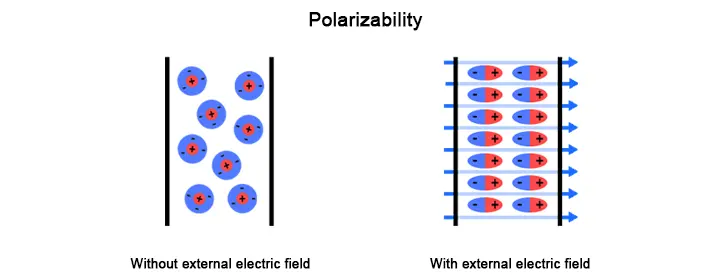Permittivity and Relative Permittivity
What is Permittivity
Permittivity, denoted by the letter (ε), is a measure of how easily a material can be polarized when subjected to an external electric field, and it speaks directly to the characteristic of a given material’s dielectric strength. The permittivity of a material can differ widely from substance to substance, and it is affected by several factors, such as The frequency of the applied field, position in the medium, temperature, and humidity.
Relative Permittivity & The Permittivity of Vacuum
Relative Permittivity (εr), also known as Dielectric Constant, is defined as the ratio between the permittivity of a material or substance to the permittivity of vacuum. It is simply a measure of how much a material’s permittivity differs from that of a vacuum. In other words, it’s a way to compare the permittivities of different materials.
Vacuum permittivity (εo), sometimes referred to as the electric constant or the permittivity of free space, is the permittivity value of absolute vacuum., and it is equal to 8.85 x 10-12 (F/m).
Electric Polarization

Polarization is the process by which a material acquires an electric dipole moment (separation of negative and positive charges) when subjected to an external electric field.
When dielectric materials are subjected to an external electric field, a material with high permittivity will polarize more than a material with low permittivity, which in turn allows it to store more energy.
Formula & Units
The permittivity of linear, homogeneous, and isotropic materials can be found as:
Where:
- ε is the permittivity in farads per meter (F/m)
- D is the displacement field in coulombs per square meter (C/m2)
- E is the electric field in volts per meter (V/m)
Where:
- εr is the relative permittivity or dielectric constant
- ε is the permittivity of the material (F/m)
- εo is the permittivity of vacuum or free space (8.85 x 10-12 F/m)
The SI unit of permittivity is farads per meter (F/m).
The relative permittivity is a unitless value as it is the ratio between two similar quantities.
Factors Affecting Permittivity
The permittivity of a material is affected by several factors, including:
- Type of Material: The permittivity of a material depends on its chemical composition and structure. Materials with a higher concentration of free charge carriers, such as metals, generally have low permittivity, while insulators have high permittivity.
- Temperature: Temperature affects the permittivity of a material by influencing the motion of its free charge carriers. As temperature increases, the mobility of charge carriers also increases, leading to an increase in permittivity.
- Pressure: Pressure can also affect the permittivity of a material. This is because pressure can cause a change in the material’s molecular structure or crystal lattice.
- Frequency of the Applied Electric Field: The permittivity of a material is also frequency-dependent. At low frequencies, the material’s permittivity is usually high, while at high frequencies, the permittivity decreases.
- Chemical Composition: The chemical composition of a material can also influence its permittivity. The presence of impurities, defects, or surface charges can modify the polarization behavior of the material and alter its permittivity.
Understanding the factors that affect permittivity is crucial in designing and optimizing electronic devices and materials for specific applications.
Applications of Permittivity
Permittivity has several important applications in science, technology, and many other industries. Some of these applications include:
- Capacitors: The permittivity of a material is a critical parameter in the design of capacitors. A higher permittivity material can store more electric charge and thus allows for the design of capacitors with higher capacitance.
- Dielectric Materials: Permittivity is a key parameter in the design of dielectric materials used in electronic devices, such as insulators, to prevent current flow or to store electric charge.
- Antennas: Permittivity is an essential parameter for the performance of antennas. The selection of dielectric materials and their permittivity can significantly impact the radiation pattern, impedance, and bandwidth of an antenna.
- Microwave and Optical Applications: In microwave and optical applications, the permittivity of a material is important in determining the speed of propagation of electromagnetic waves, reflection and transmission of light, and the design of waveguides.
- Medical Imaging: The permittivity of biological tissues can be used to create images of internal structures in the human body. This technique, known as electrical impedance tomography, can be used for non-invasive medical imaging.
Frequently Asked Questions
- What is the difference between permittivity and relative permittivity?
- Permittivity is a measure of a material’s ability to store electrical potential energy when subjected to an electric field. Relative permittivity, also known as dielectric constant, is the ratio of the permittivity of a substance to that of free space.
- What is the relative permittivity of free space?
- Relative permittivity is the ratio of a material’s permittivity to the permittivity of free space or vacuum, thus the relative permittivity of free space or vacuum is equal to one.
- Can relative permittivity be less than 1?
- No, vacuum has the lowest permittivity, and since relative permittivity measures the permittivity of a material or substance relative to that of vacuum, it cannot be less than one.
- What is the minimum value of relative permittivity?
- Vacuum has the minimum permittivity value, and by definition, its relative permittivity is equal to one.
- Are relative permittivity and dielectric constant the same?
- Yes, relative permittivity is sometimes referred to as dielectric constant.
- What is anisotropic permittivity?
- Anisotropic permittivity refers to a material’s permittivity that varies with direction. In other words, the permittivity of the material is different along different axes or directions. Anisotropic permittivity is observed in materials that have an oriented molecular structure or crystal lattice.
